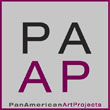« Reviews
Domingo De Lucía: Between Walls
MIArt Space - Miami
Curated by Felix Suazo
By Raisa Clavijo
Earlier this year, Domingo De Lucía exhibited in “Between Walls,” a show that assembled works from his various recent projects, at MIArt Space in Miami. The curatorial concept proposed reflecting on the barriers that man has constructed around himself and that in the short or long term restrict his individual freedom. These barriers can be both physical and virtual, as well as geographic, political, cultural, racial, economic or based on class. The project is a reflection on how, although for generations man has moved around the world seeking a better life, frontiers that impede free circulation still persist. De Lucía starts with the premise that the root of these problems is in the mind of man, in the fear of “the different,” leading to rejection and discrimination.
In a general sense, De Lucía’s oeuvre is based on the premise that creation is intimately tied to social processes. Since the 1970s, he has developed an extensive body of work and, since 1997, he has been a member of Grupo Provisional, a collective of artists that includes Juan José Olavarría, David Palacios, Juan Carlos Rodríguez and Félix Suazo. De Lucía conceives of art as an instrument of change. His creative strategy dialogues with the contribution of other creators, and even with that of professionals in other disciplines, in order to recycle objects, processes and products that already exist in the cultural market and which already have a known significance and function. The originality in his work is not always due to creating a new product from raw material, but rather, from giving new meaning to a product and presenting it in a new context of metaphoric resonance with art. His creative work abounds with installations, interventions and social actions. His strategy is reminiscent of that enunciated by Bourriad in Postproduction (2002), whereby the artist is seen as a DJ or content programmer whose mission is to identify cultural objects and symbols that he will later repurpose and reinsert. Each of the pieces gathered together in this exhibition are the result of a long process of labor and investigation, a process more important than the final result itself. The work does not conclude with the exhibition, rather it is extended by interaction with the public, who in turn continue it and enrich it.
In this show, the walls were painted red and the space was divided by a low brick wall that visitors were obliged to cross. Large-format desert photographs, which evidenced traces of human footprints, hung on one of the walls. The video Around Ego, produced during the 2012 Burning Man festival in Black Rock Desert, Nev., was projected on the front wall. The video consists of a long sequence of circular rotations around Ego, the 20ft-high ephemeral sculpture presented at this event by the artists Laura Kimpton and Mike Garlington. De Lucía’s video constructs meta-textual references based on the work that these two artists conceived to be burned during the festival. The rotations of the camera around the sculpture allude to how the ego dominates human behavior, creating both real and imaginary barriers and impacting laws governing politics, the economy and society in general.
Another project, Burning Passport, made its first appearance at Burning Man in 2012. The artist conceived of a passport to freedom that he distributed amongst the public, questioning the existence of a world divided by borders that requires people to carry documentation in order to cross them.
The color red on the exhibition walls did not only allude to the ideologies of the left, many of which turned into dictatorships and the cause of migrations and exiles, but it was also the result of De Lucía’s extensive research into this color. In his project Std. Color (2011), the artist worked alongside chemical engineers from Artquimia, the paint and art materials factory in Valencia, Venezuela. The project starts with the premise that in the paint manufacturing industry there are formulae that experts use to evaluate the quality of the pigment in order to determine coverage, acidity, texture and resistance to bacteria. De Lucía analyzed the behavior of the color red, and based on that he created a series of stencils and graphics that were part of an exhibition at El Anexo in Caracas. The artist drew a correlation between the technical industrial requirements for evaluating the paints and those expected of Venezuelan citizens in adhering to the ideologies of the left. As part of Std. Color, he also produced a collection of scholastic materials in red tones that were inserted in commercial channels of distribution as an analogy of the zeal for ideological homogeneity of this system of government.

Domingo De Lucia, Social Entropy, 2012, acrylic paint and aerobic bacteria, installation view at MIArt Space, Miami, 2017.
As a result of these studies of color, De Lucía was also able to confirm that within the pigment production industry, the color red is the most fragile tone, the most sensitive to degradation as a result of its exposure to light, climatic agents and bacteria. Based on this, the artist developed the series Analogy and Social Entropy, which were also displayed at the exhibition in Miami. These are comprised of paintings, stylistically associated with minimalism and matter painting, in which the red pigment that dominates the surface was not treated with bactericide. In a short time, bacteria began eating the pigment and eventually ended up devouring each other. The pieces constitute a metaphor for political systems that become ineffective as a result of corruption and the struggle for power. In Social Entropy, De Lucía draws an analogy between the decomposition of red pigments on a surface and the crisis of ethical and moral values in today’s world, which leads to violence, terrorism and intolerance.
With “Between Walls,” De Lucía proposes a set of visual metaphors that basically calls for tearing down mental walls, those invisible barriers that impede human evolution.
(May 5 - 28, 2017)
Works Cited
- Bourriaud, Nicolas. Postproduction. New York: Lukas & Sternberg, 2002.
Raisa Clavijo is an art critic, curator and art historian based in Miami. She is founder and editor-in-chief of ARTPULSE and ARTDISTRICTS magazines.
Filed Under: Reviews




































Leave a Reply
You must be logged in to post a comment.